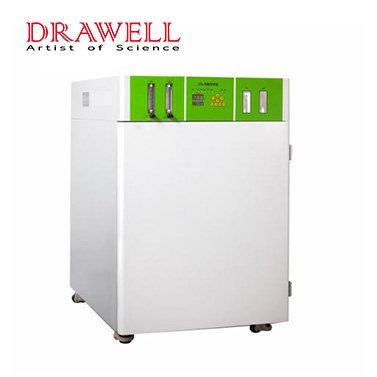CO2 incubators represent indispensable equipment within laboratory settings across various scientific domains, spanning cell culture, microbiology, and molecular biology. These incubators offer a meticulously controlled environment indispensable for the cultivation and upkeep of cells and organisms. While theefficiency and reliability of CO2 incubators are unquestionable, adherence to specific precautions is imperative to guarantee their safe and effective utilization.

General Guidelines
Begin by acquainting yourself with the user manual and the manufacturer’s instructions, as nuances in features and operational guidelines may vary among different incubator models. Proper installation and routine maintenance are pivotal to ensuring optimal functionality and averting malfunctions. Moreover, embracing fundamental laboratory safety practices, including the utilization of personal protective equipment (PPE), is indispensable to safeguard oneself and uphold a secure working milieu.
Safety Measures
Ventilation: Ensuring adequate ventilation in the incubator room is crucial to prevent the accumulation of CO2 and other gases, thereby upholding a safe working environment.
Gas Supply: Regular inspection and maintenance of the gas supply lines are imperative to forestall leaks or contamination. Promptly address any signs of damage or deterioration and adhere to proper gas handling procedures and cylinder usage.
Alarm System: Installing a backup alarm system capable of detecting deviations in temperature, CO2 levels, or power failures is advisable. This redundancy facilitates the timely detection of anomalies, enabling swift corrective action.
Cleanliness: Maintaining the incubator's cleanliness and free from debris or spills is paramount to prevent contamination or damage. Regularly clean and disinfect interior surfaces in line with the manufacturer’s recommendations.
Hazardous Substances: Exercise caution when handling hazardous substances or samples within the incubator. Adhere to safety protocols, including the use of containment systems and appropriate PPE, to mitigate the risk of exposure or accidents.

Operational Precautions
Operating Conditions: Adhere to recommended operating conditions, encompassing temperature and humidity settings, to ensure optimal growth and viability of cells or organisms.
Calibration and Validation: Periodically calibrate and validate the incubator’s sensors and controllers to ensure accurate readings and dependable operation, following the manufacturer’s guidelines for frequency and procedure.
Avoid Overcrowding: Avoid overcrowding the incubator to facilitate proper air circulation, pivotal for maintaining a stable and uniform environment. Ensure samples and containers are adequately spaced to allow for sufficient airflow.
Minimize Door Openings: Limit the frequency and duration of door openings to prevent fluctuations in temperature and CO2 levels, which can disrupt internal conditions and compromise cultures' growth and integrity.
Water Pan/Humidity System: If applicable, regularly inspect and maintain the water pan or humidity system to ensure proper functionality. Monitor water levels and clean or replace water as needed to maintain desired humidity levels.
Sample Handling Precautions
Containers and Labeling: Utilize appropriate containers and vessels to prevent sample leakage or contamination. Ensure all containers are tightly sealed to prevent gas exchange and accurately label samples to avoid confusion or cross-contamination.
Hazardous Samples: When handling hazardous or volatile samples, employ suitable secondary containment systems to minimize the risk of exposure or release. Adhere to proper decontamination procedures before removing samples to prevent external contamination.
Emergency Preparedness
Emergency Shutdown: Familiarize yourself with the emergency shutdown procedure and the location of safety equipment, such as fire extinguishers or emergency exits, ensuring swift and safe response in critical situations.
Contact Numbers: Keep emergency contact numbers easily accessible near the incubator, including those for maintenance personnel, laboratory management, and relevant safety personnel.
Backup Power: Establish a backup power source or contingency plan to maintain critical incubator conditions during power outages. Utilize uninterruptible power supply (UPS) systems or generators to ensure uninterrupted operation and prevent experiment disruption.
Regular Testing: Routinely test and maintain backup systems, including gas supply, alarms, and temperature monitoring, to ensure operational readiness when required.
Training and Documentation
Personnel Training: Ensure all personnel using the incubator receive adequate training encompassing its operation, maintenance, and safety protocols. This training should encompass proper usage, emergency procedures, and routine maintenance.
Logbook: Maintain a comprehensive logbook documenting regular checks, maintenance activities, and any incidents or deviations observed. This logbook serves as a valuable resource for tracking performance and identifying trends or issues necessitating attention.
Periodic Reviews: Conduct periodic reviews and audits of incubator usage and safety protocols to identify areas for improvement and update protocols accordingly, ensuring ongoing safety and reliability.
In Conclusion
Adhering to requisite precautions when utilizing a CO2 incubator is paramount to ensuring laboratory personnel safety and experiment integrity. By adhering to these guidelines, potential risks can be mitigated, fostering an optimal environment for cell culture and other research endeavors. Continuous monitoring, routine maintenance, and ongoing training are pivotal to maximizing the incubator's performance and longevity.

